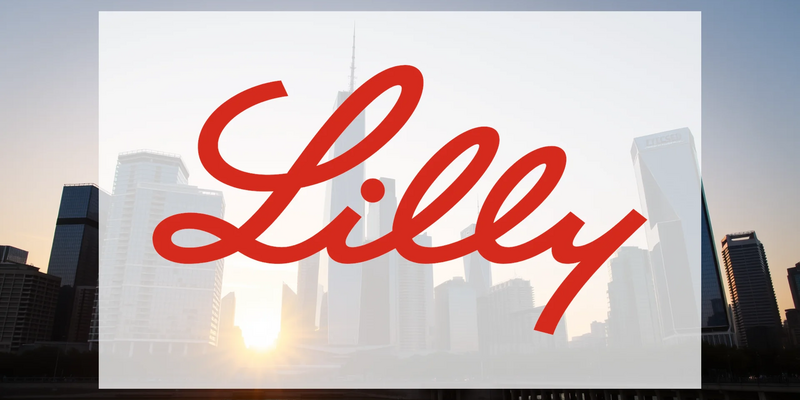A Landmark Achievement Overshadowed by Market Jitters
24.11.2025 - 15:04:04Eli Lilly US5324571083
Eli Lilly & Company has etched its name in the annals of corporate history, becoming the first pharmaceutical firm globally to surpass a market valuation of one trillion dollars. This monumental feat, fueled by the exceptional performance of its blockbuster drugs Mounjaro and Zepbound, seemed to signal an unstoppable ascent. However, in a surprising turn, the company's shares experienced a sharp 5% decline the very next day. This sudden shift has left investors questioning the catalyst and the path forward for the healthcare giant.
The unexpected mid-week sell-off was not triggered by any negative news from Eli Lilly itself. Instead, the downturn was set in motion by clinical trial setbacks at its Danish competitor, Novo Nordisk. The rival's hopeful drug candidate, Semaglutid, intended for Alzheimer's treatment, failed to demonstrate the desired effect in slowing the disease's progression during its Phase 3 studies.
The financial markets reacted with palpable anxiety. The underlying fear among investors appears to be that this failure could dampen the widespread enthusiasm for GLP-1 receptor agonists, the class of drugs to which Eli Lilly's top sellers belong. These medications had been viewed as promising candidates for treating neurodegenerative conditions. Despite the market's nervousness, many financial analysts consider this reaction overblown. They suggest that Eli Lilly could, in fact, stand to gain in its core markets of diabetes and obesity treatment if Novo Nordisk's momentum is hindered.
Unshaken Confidence: Wall Street's Bullish Outlook Endures
Notwithstanding the recent volatility, experts on Wall Street have reaffirmed their strongly positive stance on Eli Lilly. Financial institutions have been actively raising their price targets in a show of confidence. Morgan Stanley increased its target to $1,290, with Bernstein following closely and setting an even higher target of $1,300. This optimistic reassessment was mirrored by Truist Securities and JPMorgan, which also revised their forecasts upward.
The rationale behind this sustained optimism is clear. The market for GLP-1-based therapies is expanding precisely as projected, if not exceeding expectations. Commanding nearly 58% of the U.S. market share for incretin analogs, Eli Lilly dominates one of the pharmaceutical industry's most profitable segments. The revenue stream from Mounjaro and Zepbound alone reached almost $25 billion in the first nine months of 2025. Projections indicate the global obesity market could balloon to an annual value of $100 billion by 2030.
A Series of Record-Breaking Quarters
The company's financial results tell a compelling story of growth. For the third quarter of 2025, revenue surged by an impressive 54% to $17.6 billion. The adjusted earnings per share saw a dramatic increase, jumping from $1.18 to $7.02 year-over-year. Reflecting this robust performance, the company's leadership confidently raised its full-year guidance, projecting revenue between $63.0 billion and $63.5 billion and earnings per share in the range of $23.00 to $23.70.
Should investors sell immediately? Or is it worth buying Eli Lilly?
The crescendo of this success was reached on November 21, 2025, when Eli Lilly's market capitalization crossed the one-trillion-dollar threshold, a first for any company in the healthcare sector. This milestone places the pharmaceutical leader into an exclusive club previously inhabited only by technology behemoths such as Apple, Microsoft, and Alphabet.
Future Growth Fueled by a Promising Pipeline
Eli Lilly is not complacent despite its current achievements. The company's development pipeline contains several promising drug candidates that could provide the next wave of growth:
- Orforglipron: An orally administered GLP-1 agonist, for which global regulatory submissions are anticipated by the end of 2025.
- Retatrutide: A triple-hormone agonist that is expected to yield Phase 3 trial data soon.
- Eloralintide: An amylin receptor agonist now entering Phase 3 clinical studies.
These potential therapies target not only diabetes and obesity but also a significantly broader range of medical conditions, potentially unlocking access to multibillion-dollar markets.
Navigating the High Stakes of Success
The elevated price targets from analysts suggest a potential upside of 20% to 25% for the stock. Yet, the recent price volatility serves as a stark reminder that the company is now held to an exceptionally high standard. Any disappointment, whether originating from Eli Lilly or its competitors, is likely to be met with swift and severe punishment from the markets.
The coming quarters will be a critical test of whether the world's first trillion-dollar pharmaceutical company can live up to its own lofty standards. As competitive pressures intensify and new players enter the GLP-1 market, Eli Lilly must continue to deliver strong results from its established products while successfully advancing its pipeline. The expectations are, without a doubt, immense.
Ad
Eli Lilly Stock: Buy or Sell?! New Eli Lilly Analysis from November 24 delivers the answer:
The latest Eli Lilly figures speak for themselves: Urgent action needed for Eli Lilly investors. Is it worth buying or should you sell? Find out what to do now in the current free analysis from November 24.
Eli Lilly: Buy or sell? Read more here...


